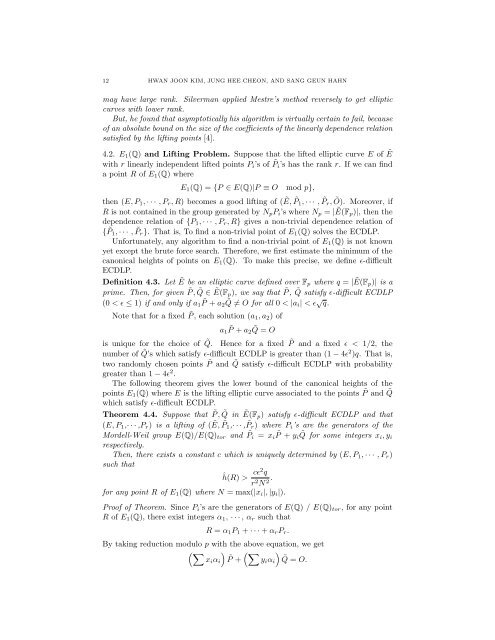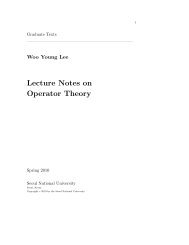ON REMARKS OF LIFTING PROBLEMS FOR ELLIPTIC CURVES 1 ...
ON REMARKS OF LIFTING PROBLEMS FOR ELLIPTIC CURVES 1 ...
ON REMARKS OF LIFTING PROBLEMS FOR ELLIPTIC CURVES 1 ...
You also want an ePaper? Increase the reach of your titles
YUMPU automatically turns print PDFs into web optimized ePapers that Google loves.
12 HWAN JO<strong>ON</strong> KIM, JUNG HEE CHE<strong>ON</strong>, AND SANG GEUN HAHN<br />
may have large rank. Silverman applied Mestre’s method reversely to get elliptic<br />
curves with lower rank.<br />
But, he found that asymptotically his algorithm is virtually certain to fail, because<br />
of an absolute bound on the size of the coefficients of the linearly dependence relation<br />
satisfied by the lifting points [4].<br />
4.2. E 1 (Q) and Lifting Problem. Suppose that the lifted elliptic curve E of Ẽ<br />
with r linearly independent lifted points P i ’s of ˜P i ’s has the rank r. If we can find<br />
a point R of E 1 (Q) where<br />
E 1 (Q) = {P ∈ E(Q)|P ≡ O<br />
mod p},<br />
then (E, P 1 , · · · , P r , R) becomes a good lifting of (Ẽ, ˜P 1 , · · · , ˜P r , Õ). Moreover, if<br />
R is not contained in the group generated by N p P i ’s where N p = |Ẽ(F p)|, then the<br />
dependence relation of {P 1 , · · · , P r , R} gives a non-trivial dependence relation of<br />
{ ˜P 1 , · · · , ˜P r }. That is, To find a non-trivial point of E 1 (Q) solves the ECDLP.<br />
Unfortunately, any algorithm to find a non-trivial point of E 1 (Q) is not known<br />
yet except the brute force search. Therefore, we first estimate the minimum of the<br />
canonical heights of points on E 1 (Q). To make this precise, we define ɛ-difficult<br />
ECDLP.<br />
Definition 4.3. Let Ẽ be an elliptic curve defined over F p where q = |Ẽ(F p)| is a<br />
prime. Then, for given ˜P , ˜Q ∈ Ẽ(F p), we say that ˜P , ˜Q satisfy ɛ-difficult ECDLP<br />
(0 < ɛ ≤ 1) if and only if a 1 ˜P + a2 ˜Q ̸= O for all 0 < |ai | < ɛ √ q.<br />
Note that for a fixed ˜P , each solution (a 1 , a 2 ) of<br />
a 1 ˜P + a2 ˜Q = O<br />
is unique for the choice of ˜Q. Hence for a fixed ˜P and a fixed ɛ < 1/2, the<br />
number of ˜Q’s which satisfy ɛ-difficult ECDLP is greater than (1 − 4ɛ 2 )q. That is,<br />
two randomly chosen points ˜P and ˜Q satisfy ɛ-difficult ECDLP with probability<br />
greater than 1 − 4ɛ 2 .<br />
The following theorem gives the lower bound of the canonical heights of the<br />
points E 1 (Q) where E is the lifting elliptic curve associated to the points ˜P and ˜Q<br />
which satisfy ɛ-difficult ECDLP.<br />
Theorem 4.4. Suppose that ˜P , ˜Q in Ẽ(F p ) satisfy ɛ-difficult ECDLP and that<br />
(E, P 1 ,· · · ,P r ) is a lifting of (Ẽ, ˜P 1 ,· · · , ˜P r ) where P i ’s are the generators of the<br />
Mordell-Weil group E(Q)/E(Q) tor and ˜P i = x i ˜P + yi ˜Q for some integers xi , y i<br />
respectively.<br />
Then, there exists a constant c which is uniquely determined by (E, P 1 , · · · , P r )<br />
such that<br />
ĥ(R) > cɛ2 q<br />
r 2 N 2 .<br />
for any point R of E 1 (Q) where N = max(|x i |, |y i |).<br />
Proof of Theorem. Since P i ’s are the generators of E(Q) / E(Q) tor , for any point<br />
R of E 1 (Q), there exist integers α 1 , · · · , α r such that<br />
R = α 1 P 1 + · · · + α r P r .<br />
By taking reduction modulo p with the above equation, we get<br />
(∑<br />
xi α i<br />
)<br />
˜P +<br />
(∑<br />
yi α i<br />
)<br />
˜Q = O.













